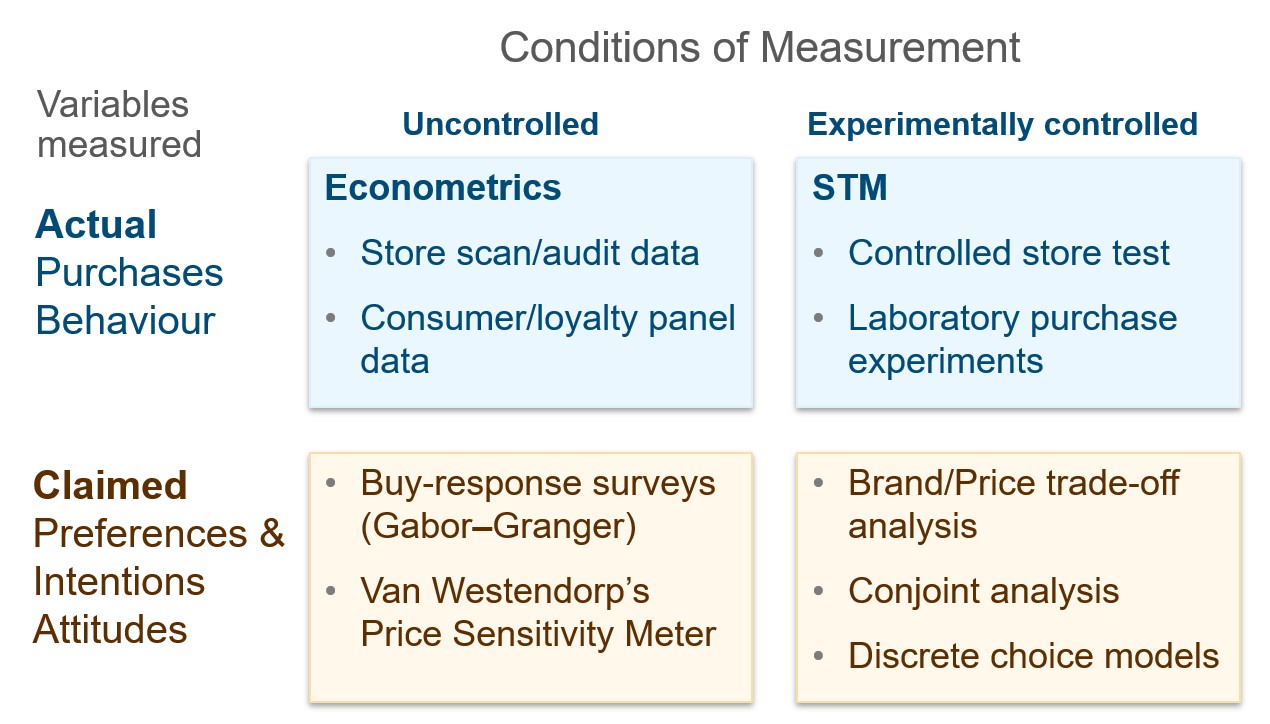
Exhibit 16.3 Pricing research methods.
Pricing research is a
relatively young and evolving field of market research. Interest on the
subject grew in the 1960s, initially within FMCG, and has since spread across
other sectors.
Exhibit 16.3 Exhibit 16.3 categorizes several well-known pricing
research methods. Some of the earliest organized studies on pricing were conducted in
the UK during the 1950s to examine the influence of price on consumer behaviour for FMCG
products. In the 1960s, economists Andre Gabor and Clive Granger conducted a small-scale
survey on price consciousness and developed of the “Buy Response” curve or demand curve.
Later, in 1976, Dutch economist Peter van Westendorp introduced the price sensitivity meter
(PSM), a technique for determining the acceptable price range for new products.
Indirect Approach
Gabor–Granger’s buy response curve and the
price sensitivity meter (PSM) are examples of the indirect or psychological approaches to pricing
research where respondents are presented with a product or service at different
price points and asked their likelihood to purchase at those prices. These
methods are better suited for inferring price-related behaviour of new
categories where direct comparison of alternatives at point-of-decision is not
realistic.
Direct Approach
In contrast to indirect
methods, the direct (or representational) approach presents a “purchase
scenario” to respondents, complete with competitive products and their prices. It
reflects a more realistic scenario for most consumer goods, where products are
displayed alongside each other at retail outlets. Direct approach methods
include brand price trade-off (BPTO), conjoint analysis and discrete choice
modelling.
Conjoint analysis was
developed by Paul Green at the Wharton School in the 1970s. It is a predictive
technique that may be used to determine customers’ preferences for the
different products at different price points. Brand price trade-off, which is a
simpler, easy to implement, predictive technique, was developed around the same
time.
In the 1980s Richard Johnson
(founder of Sawtooth Software) developed adaptive conjoint analysis,
and Jordan Louviere (University of Iowa) developed choice-based approaches to conjoint analysis. Choice-based conjoint or discrete choice models
gained popularity in the 1990s.
Econometrics
In addition to ad hoc
survey based methods, market response modelling techniques are extensively used
for accurately determining price elasticities in situations where historical data
(e.g., scan data or consumer/loyalty panel data) is readily available. Chapter
Marketing mix Modelling covers these methods in some detail.
Because econometrics relies on historical data it is
not possible to use it to test new products, or to test for price points that
significantly differ from historical levels.
Simulated Test Markets
Typically used for new product
launch validation, simulated test markets (STMs), provide sales
estimates of a new product prior to their launch. These methods are used
by management to make the “go/no-go” decision at the end of the new product
development process. They allow marketers to fine-tuning elements of the mix including
price.